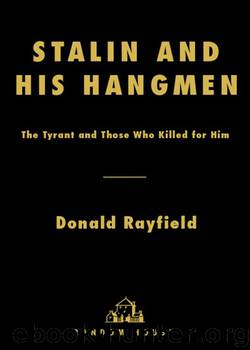Stalin and His Hangmen: An Authoritative Portrait of a Tyrant and Those Who Served Him by Donald Rayfield

Author:Donald Rayfield [Rayfield, Donald]
Language: eng
Format: epub
Tags: Europe, 20th Century, Modern, General, Nonfiction, Historical, Biography & Autobiography, World, History
ISBN: 9780141914190
Google: TGvUsBAxTUUC
Publisher: Penguin UK
Published: 2005-03-31T20:36:11+00:00
When Kamenev and Zinoviev were charged with Kirov’s murder, the new edition of Machiavelli was stopped, and the volume with Kamenev’s foreword was pulped.
Weeks passed before Zinoviev and Kamenev were charged. First, Stalin and Iagoda replaced the disgraced Leningrad NKVD men with their Moscow chiefs. Iakov Agranov, who had fabricated conspiracies ever since 1921, conducted the main interrogations assisted by an articulate prosecutor, Lev Sheinin, who made a good living writing up his investigations in the style of Sherlock Holmes stories. Agranov and Sheinin, a sledgehammer and a crowbar, broke everyone who had unluckily befriended, or merely met, Leonid Nikolaev. Soon a worse ogre than Agranov appeared. Nikolai Ezhov, although officially a Central Committee not an NKVD man, came to interrogate some of the accused.
Stalin personally wrote out the indictment of Nikolaev and his alleged associates. Stalin’s text delighted Vyshinsky, who had only to add the finishing touches. The indictment stated that the accused were wreaking vengeance on Kirov for crushing the Zinovievites. The decree of December 1 was made retroactive. The trial started at 2:40 p.m. on December 28 and sentence was pronounced at 6:40 the next morning. On December 25 Vasili Ulrikh, by now a notorious hanging judge, had visited Stalin to find out what sentence to pass. Nevertheless, Ulrikh telephoned Stalin twice during the trial, so perturbed was even he by Nikolaev’s insistence that he had acted alone. Ulrikh’s fellow judges and his common-law wife both recall that he wanted to refer the case for further investigation, but that Stalin was adamant: “No further investigation, finish the trial . . . they must all have the same sentence—shooting.” This snuffed out the last spark of legality in Ulrikh. He never demurred again.
All fourteen were shot that same morning. Agranov and Vyshinsky stood by the cells as the victims went to the death cellar. Nikolaev’s executioner reminisced: “I picked Nikolaev up by his trousers. I was crying. I was so sorry for Kirov.” The last to be shot was the second arrested, Ivan Kotolynov. Agranov and Vyshinsky asked him, “You’ll be shot now, so tell the truth, who organized Kirov’s murder, and how?” A guard testified twenty-two years later that Kotolynov replied, “The whole of this trial is nonsense. People have been shot. I’m going to be shot now. But none of us, except Nikolaev, is guilty of anything.”
These executions were only the beginning. In March, Nikolaev’s wife, sister-in-law, and brother-in-law were shot. Leningrad party officials were told to list former Zinoviev supporters. They replied that it would be easier to list those who had not supported Zinoviev.9 Throughout December 1934 and January 1935, the Leningrad party was cleared of those who had worked under Zinoviev: 663 were exiled to Siberia, 325 to other cities in European Russia. Almost every Bolshevik who had belonged to a fraction, even before Lenin’s death, was expelled and hundreds of “democratic centralists” and trade unionists were sent to the backwoods, effectively holding pens for the condemned. After Leningrad’s NKVD and party came
Download
This site does not store any files on its server. We only index and link to content provided by other sites. Please contact the content providers to delete copyright contents if any and email us, we'll remove relevant links or contents immediately.
Fanny Burney by Claire Harman(25800)
Empire of the Sikhs by Patwant Singh(22193)
Out of India by Michael Foss(16319)
Leonardo da Vinci by Walter Isaacson(11932)
Small Great Things by Jodi Picoult(6115)
The Six Wives Of Henry VIII (WOMEN IN HISTORY) by Fraser Antonia(4806)
The Wind in My Hair by Masih Alinejad(4434)
The Lonely City by Olivia Laing(4135)
The Crown by Robert Lacey(4122)
A Higher Loyalty: Truth, Lies, and Leadership by James Comey(4046)
The Iron Duke by The Iron Duke(3659)
Millionaire: The Philanderer, Gambler, and Duelist Who Invented Modern Finance by Janet Gleeson(3583)
Sticky Fingers by Joe Hagan(3462)
Alive: The Story of the Andes Survivors by Piers Paul Read(3326)
Papillon (English) by Henri Charrière(3283)
Joan of Arc by Mary Gordon(3275)
Stalin by Stephen Kotkin(3099)
Aleister Crowley: The Biography by Tobias Churton(3034)
Ants Among Elephants by Sujatha Gidla(2933)
